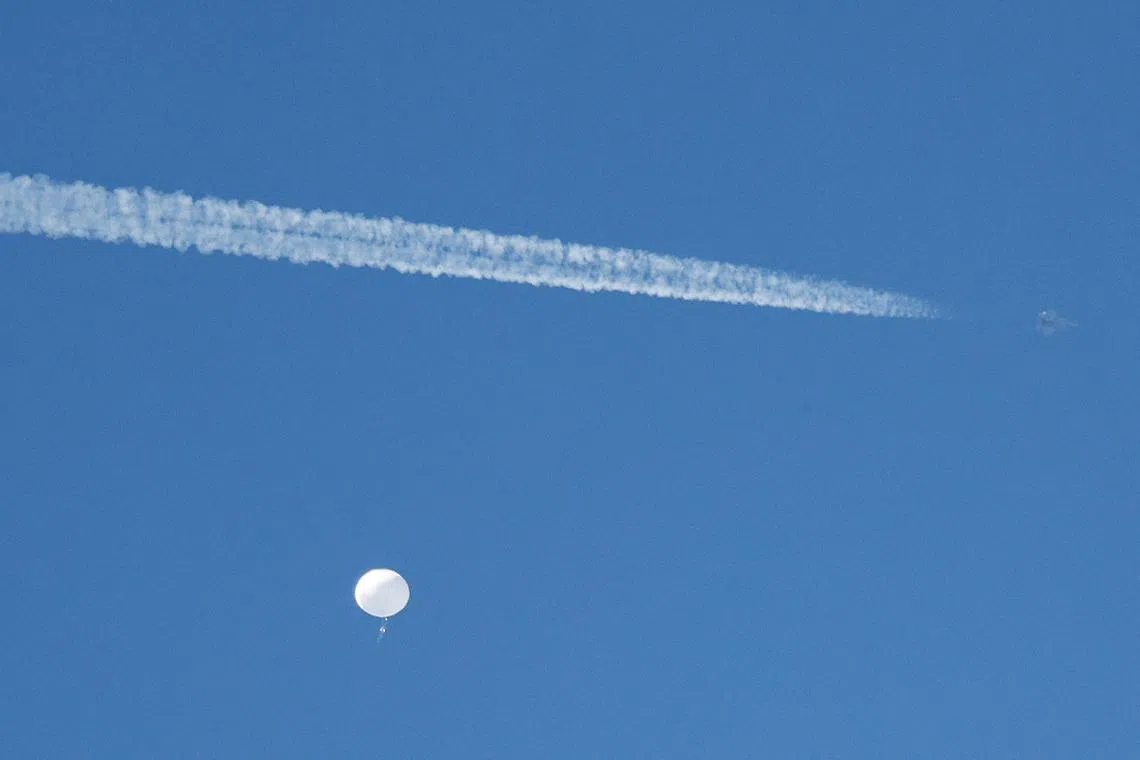US-China relations: A long history of balloons, bombs and drones
Sign up now: Get insights on Asia's fast-moving developments

A jet flies by a suspected Chinese "spy" balloon as it floats off the coast in Surfside Beach, South Carolina, on Feb 4.
PHOTO: REUTERS
Follow topic:
NEW YORK – The dramatic downing of a suspected Chinese spy balloon off the South Carolina coast
Several spats involve the South China Sea, as the US implicitly challenges Beijing’s territorial ambitions in an economically and geopolitically important part of the Western Pacific.
Here is a brief history of some incidents that could easily have spun out of control.
2022: Fighter jet near-miss
A Chinese Su-30 fighter jet had an “unsafe interaction” with a US C-130 special operations plane in the South China Sea in June 2022, Politico reported weeks after the incident. No details or exact date were provided.
China’s military pilots around that time were said to have been acting more aggressively in the region in various interactions with Australian and Canadian aircraft.
“We’ve seen an alarming increase in the number of unsafe aerial intercepts and confrontations at sea by PLA (People’s Liberation Army) aircraft and vessels,” US Defence Secretary Lloyd Austin at the time.
2022: US Warship warned - again
In January 2022, Chinese forces tracked and warned the USS Benfold when it entered waters Beijing claims
The US Navy said its mission was in accordance with international law and in line with its commitment to defend “every nation’s right to fly, sail, and operate wherever international law allows”.
The Benfold made repeated forays into waters claimed by China during 2022, including sailing through the Taiwan Strait at least three times in July.
2021: US warship warned
In May 2021, Beijing said the USS Curtis Wilbur illegally entered its territorial waters near the Paracel Islands
“US behaviour violates international law and basic norms of international relations, and increases regional security risks,” the PLA said in a statement.
Navy officials denied the guided-missile destroyer had been “expelled” by China.
The Curtis Wilbur “asserted navigational rights and freedoms in the vicinity of the Paracel Islands, consistent with international law,” the 7th Fleet said in a statement.
2018: Warships almost collide
The guided missile destroyer USS Decatur in September 2018 got perilously close to its Chinese counterpart in contested waters – near reefs in the South China Sea occupied by China but also claimed by Vietnam, Taiwan and the Philippines.
The US Navy said in a statement that the two ships came within 41m, or what amounts to seconds away from a collision.
The Chinese vessel “conducted a series of increasingly aggressive maneuvers accompanied by warnings for the Decatur to depart the area”, the US Navy said.
2016: US Drone captured
China in December 2016 scooped up an underwater US drone in international waters, in plain sight of the USNS Bowditch, an oceanographic survey ship.
The unmanned underwater vehicle, which the Pentagon said was operating lawfully, was allegedly collecting data about water conditions – including salinity and temperature – about 50 nautical miles north-west of Subic Bay, off the Philippines.
The drone was returned following a formal protest by Washington. At the time the provocation was seen as a challenge to the incoming Donald Trump administration.
2001: Hainan Island
An international dispute followed the mid-air collision of a US Navy EP-3E intelligence aircraft with a Chinese J-811 fighter jet about 110km from the Chinese island of Hainan in April 2001.
The Chinese jet was lost in the skirmish with its pilot missing and presumed dead. The much larger US plane made an unauthorised emergency landing on Hainan after its crew destroyed sensitive items. The 24 US airmen were detained for 11 days; Washington reimbursed Beijing for their care and feeding.
It fell to US President George W. Bush to craft a response to Beijing that expressed regret but did not admit to wrongdoing.
1999: US bombs Chinese embassy
Tensions flared in May 1999 when the US struck China’s embassy in Belgrade, Yugoslavia, with five guided bombs, killing three people. According to the US at the time, the intended target was a nearby Yugoslav military facility. Beijing called the bombing a “barbarian act and a gross violation of Chinese sovereignty”.
President Bill Clinton apologised to Beijing for what he called an accident. Central Intelligence Agency director George Tenet later told Congress that his agency had identified the wrong coordinates. The actual motive for the strike remains in dispute. BLOOMBERG

